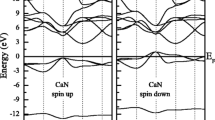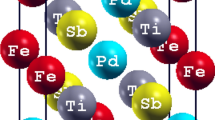Abstract
First principles study is reported for the band structures, site and angular momentum decomposed density of states, and the electronic charge density distributions in high-temperature structural materials D88-Ti5Si3 with the addition of low-rate metalloid: carbon, boron, nitrogen and oxygen. It shows that how the addition of metalloid atoms can stabilize Nowotny phase of Ti5Si3 from the viewpoint of the electron structure.
Similar content being viewed by others
References
Nowotny H.Electronic Structure and Alloy Chemistry of the Transition Elements. New York: Plenum Press, 1963, 179
Meschter P J, Schwartz D S. Silicide-matrix materials for high-temperature applications.Journal of Metals, 1989,41(11): 52–55
Frommeyer Georg, Rosenkranz Rainer, Luecke Chrita. Microstructure and properties of the refractory intermetallic Ti5Si3 Compound and the unidirectionally solidified eutectic Ti−Ti5Si3 alloy.Zeitschrift fur Metallkunde, 1990,81 H(5): 307
Rosenkrom Z R, Frommeyer G, Smarsly W. Microstructure and properties of high melting point intermetallic Ti5Si3 and TiSi2 compounds.Mater Sci (Eng), 1992, A152: 288–294
Quakerndat J, Visser J W. Lattic dimensions of low-rate metalloid-stabilized Ti5Si3.High Temperatures-High Pressures, 1974,6: 515–517
Tsuyoshi Kaijitani, Tomohiro Kawase, Kazuyoshi Yamada,et al. Site occupation and local vibration of hydrogen isotopes in hexgonal Ti5Si3H (D)1−x.Transactions of the Japan Institute of Metals, 1986,27 (9): 639–647
Ekman M, Ozolins V. Electronic structure and bonding properties of Titanium silicides.Phys Rev B, 1998,57: 4419
Adersen O K. Linear methods in band theory.Phys Rev B, 1975,12: 3060
David J S. Band structures and their interpretation.Intermetallic Compounds, 1994,1: 127
McMahan A K. Interstitial-sphere linear muffin-tin orbital structural calculations for C and Si.Phys Rev B, 1984,30: 5835
Wang D S.User’s Manual of LAPW Software Package 1996 Version. Edited by Laboratory for Surface Physics of the Institute of Physics. Beijing: Academia Sinica, 1996
Garcia E, Corbett J D. Chemistry of polar intermetallic compounds, Study of two Zr5Si3 phases, host for a diverse interstitial chemistry.Jnorganic Chemistry, 1988,27(13): 2553
Gelatt C D, Williams A R, Moruzzi V L. Theory of bonding of transition metals to nontransition metals.Phys Rev B, 1983,7: 2005
Liu H J, Ye Y Y. Electronic structure and stability of Ti-based B2 shape-memory alloys: by LMTO-ASA.Solid State Communication, 1998,106(4): 197–202
Author information
Authors and Affiliations
Additional information
Supported by the National Natural Science Fundation of China
Hong Lihua: born in 1974, Graduate student
Rights and permissions
About this article
Cite this article
Lihua, H., Yiying, Y. & Huawei, G. First principles study-D88 lattice stability of low-rate metalloid Ti5Si3 . Wuhan Univ. J. Nat. Sci. 3, 433–439 (1998). https://doi.org/10.1007/BF02830045
Received:
Issue Date:
DOI: https://doi.org/10.1007/BF02830045




